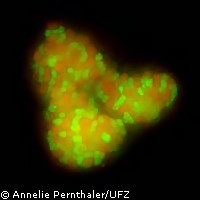Researchers isolate ocean methane-eating microbes
Researchers from Germany and the US have developed a molecular technique for capturing the microorganisms that are responsible for absorbing 80% of the ocean's methane (CH4) emissions. The team has since isolated the genes that are involved in taking up the gas. Unbeknownst to many, there are more than 100 million times more micro-organisms in the ocean than there are stars in the visible universe. These micro-organisms account for over 90% of the Earth's biomass. Since 1999, researchers have been taking an interest in a set of micro-organisms that can immediately take up 80% of the methane emitted from cold deep-sea vents. Methane is a greenhouse gas which is over 20 times more effective in trapping heat in the atmosphere than carbon dioxide (CO2). Gaining an understanding of these methane-eating microbes and other micro-organisms living in the sea has proved difficult because of their size, which makes them very hard to study. Most microorganisms cannot be grown, and thus studied, in the lab. 'Ninety-nine percent of what's out there we can't grow in the lab, including these methane-oxidizing organisms,' explains Victoria Orphan, Assistant Professor of geobiology at the California Institute of Technology (Caltech), in the US, who participated in the study. However, recent advances in molecular techniques are allowing researchers to study microorganisms in their natural habitat. For example, metagenomic analysis is a technique in which the genetic material taken from micro-organisms that are swept from their homes in a sample is sequenced wholesale. This technique can yield a wide range of general information about the microorganisms. 'We know from ribosomal RNA studies that there is a lot of microbial diversity in nature, but we don't know what the vast majority of microbes are doing,' explains Ms Orphan. 'We needed a method for separating specific organisms out of complex environments.' The method devised by the Caltech team together with scientists from the Centre for Environmental Research in Leipzig, Germany, involves attaching small ironbeads to microorganisms and pulling them out of the deep sea sediment using a magnet. The researchers found that the main methane scavengers are Archaea, a microorganism whose molecular make-up is distinct to bacteria. Thanks to their technique, the researchers also discovered an unexpected diversity in the bacterial partners that accompany the Archaea, which feed off the metabolic products of one another. In their experiments, the researchers were able to isolate the genes involved in anaerobic oxidation of methane (AOM), the main process responsible for the removal of sea-generated methane. They also discovered that the organisms possess genes for nitrogen fixation, a process that converts nitrogen gas into nourishing compounds like ammonia. 'We were surprised to see these genes in the captured cells,' says Anne Dekas, a geobiology graduate student at Caltech, 'because we thought these organisms were relatively energy-starved, and nitrogen fixation takes a lot of energy.' Their work is published in the current issue of the Journal Proceedings of the National Academy of Sciences (PNAS).
Countries
Germany



